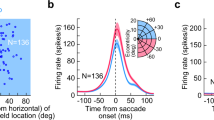Abstract.
The aim of the present study was to find out whether smooth eye movements (SEMs) evoked by superior colliculus (SC) stimulation are, as suggested by Breznen et al. (1996), artefactual eye movements resulting from a non-physiological response of the saccadic generator. This question was reinvestigated in head-restrained cats. Long-lasting SC stimulation was found to evoke, in a comparable proportion, either a single saccade followed by an uninterrupted SEM or a staircase of two or three saccades interleaved with SEMs. These two different patterns of eye movements could be elicited at a near-threshold current and at low stimulation frequencies. In most cases, SEM direction clearly differed from that of the preceding saccade. This difference between SEM and saccade directions varied in a systematic way as a function of the initial saccade direction. As demonstrated by computer simulation, this observation can be explained if the neural circuit controlling SEMs reaches a saturation level earlier than the saccadic burst-generator. Our results in cats were reminiscent of those reported by Breznen et al. (1996) in the monkey only in some instances, when high frequency stimulation (400–600 Hz) was applied. Indeed, in the case of near-threshold stimulation-elicited staircase saccades, increasing the stimulation frequency led to a progressive disappearance of the smaller subsequent saccades that were substituted by uninterrupted SEM-like movements. Altogether, the present results confirm the view that SEMs are genuine eye movements. These results rule out the hypothesis that SEMs result from a saturation of the saccadic generator and strengthen the hypothesis that SEMs and saccades are distinct movements. We suggest that the same collicular efferent cells carry out the motor command to saccadic and SEM circuits and that the position error originating from the SC may be distributed amongst separate downstream motor systems.
Similar content being viewed by others
Author information
Authors and Affiliations
Additional information
Electronic Publication
Rights and permissions
About this article
Cite this article
Missal, .M., Coimbra, .A., Lefèvre, .P. et al. Further evidence that a shared efferent collicular pathway drives separate circuits for smooth eye movements and saccades. Exp Brain Res 147, 344–352 (2002). https://doi.org/10.1007/s00221-002-1274-7
Received:
Accepted:
Issue Date:
DOI: https://doi.org/10.1007/s00221-002-1274-7




